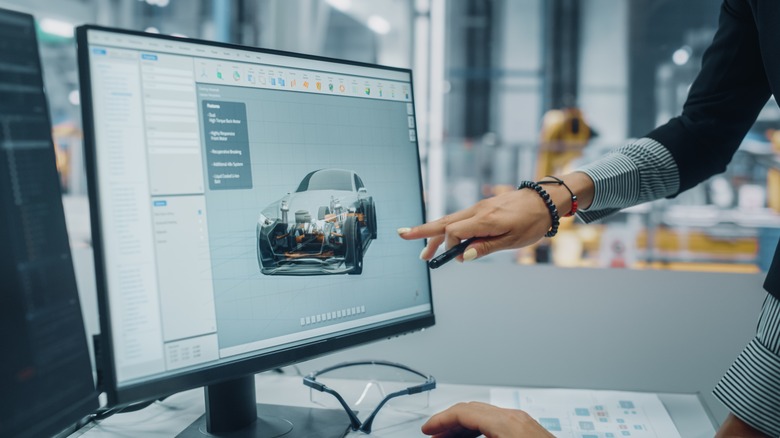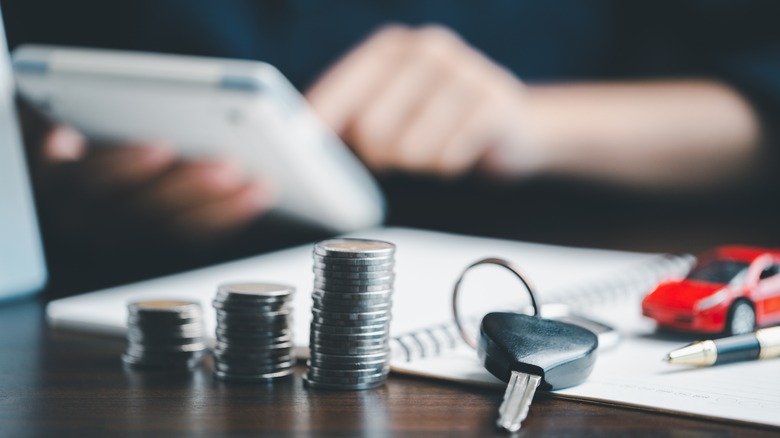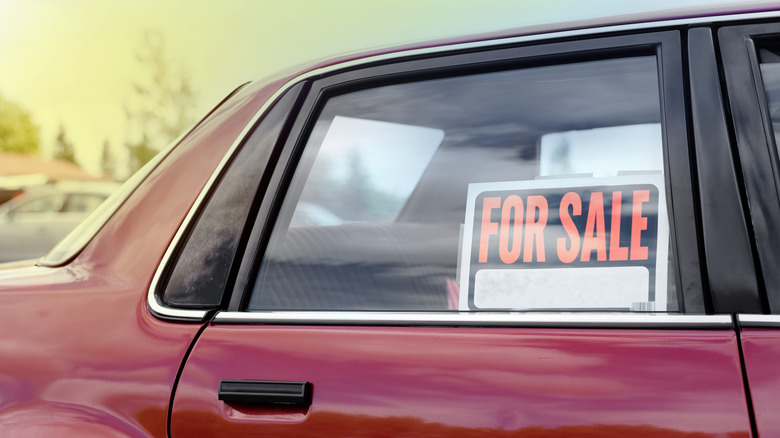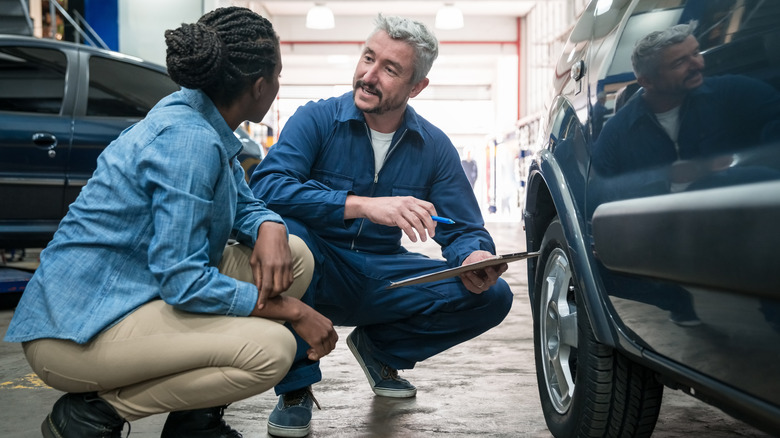11 Things People Always Get Wrong About Buying A Used Car
A Statista survey found the availability of 285.2 million automobiles in the final quarter of 2022, representing a tiny 1% increase from the prior year. That's so low a change to vehicle availability that it's demonstrative of a shortage — one stoked by semiconductor supply chain issues. It also points to changing consumer habits spurred on by Covid-19 closures, and an automotive market in the throes of adjusting to the challenges of selling vehicles online. A decline in supply with relatively unchanged demand led to higher prices for all vehicles. While that may make you want to think twice before buying a new car, buying a used car may be more affordable.
Used car prices were up as much as 45% from June 2020 to June 2021, followed by the single largest price drop for used cars since 2009 of 8.8%. With supply chain issues cooling off, and the availability of parts allowing for more inventory, the price of used cars has come down. As of December 2023, used cars cost an average of $1,600 less from their highest point the previous year, with vehicles five years or older dropping as much as 15%. Another reason to buy used is that depreciation sets in the second you drive away, with vehicles shedding as much as 20 to 30% of their book value in the first year. With that said, if you're in the market to buy used, here are some mistakes to avoid.
Not doing your research
Before you even view a vehicle, do your research about it. Knowing a little about the market, what's available for what price, and the particular benefits and flaws of the make and model of a specific vehicle can influence what vehicle you buy, and help you conclude whether now is the right time to buy one at all. For instance, look to commercial service providers like Edmunds.com, Kelly Blue Book, the National Automobile Dealer's Association, or J.D. Power for market research, pricing, valuations, financing, insurance, and expert vehicle reviews. You can immensely improve your market knowledge by perusing Kelly Blue Book and Edmunds catalog of vehicles for sale.
Thinking about what features you need versus what you don't can save you money in the long run, as can knowing about common problems related to a specific vehicle. Reach out to friends who are mechanics or car salespeople. You may have excellent resources in your social circle who can offer knowledgeable advice. If you go through with buying a used car, they're two types of people you're going to end up dealing with, anyway. If you already know people in those professions, you've got the inside track.
Not knowing your budget, and not sticking to it
So what is a budget, and what's a good one for a used car? Your budget is how much money you need to successfully manage owning your vehicle over time. Although used car prices are on the decline, they're still higher than at other points in the last 15 years, so having a budget is imperative.
According to Consumer Reports, the average price of a used car and the corresponding loan interest rate is $27,000 at 11.7%. That's a good place to start. Go for a vehicle around four years old since the newer used vehicles are relatively close in cost to buying brand new, and vehicles five or more years old usually aren't covered by warranty or have service plans unless they're EVs. The older a vehicle is, the higher your loan interest tends to be, too. Don't buy anything that you can't make a decent down payment on since, again, vehicle depreciation sets in almost immediately after you drive away, and the longer you're paying off a loan, the more likely you'll have a harder time getting any money out of your vehicle when you sell it.
Just as important as having a budget is sticking to it. Once you've made a list of monthly expenses that include current and expected liabilities related to your vehicle purchase — taxes, loans, insurance, maintenance, and gas — go for a vehicle that won't cost you more than 20% of your monthly earnings.
Not considering the cost of buying vs leasing
After you've done your research and worked out your budget, consider whether it makes sense to buy your used car or lease it. Purchasing a vehicle in the sweet spot of being old enough to be significantly cheaper than a new vehicle but not so old that it won't have many of the same features as a newer model is a plus. If the car has a little wear and tear, it takes the pressure off of you to keep it in mint condition. Another benefit of buying a used car is that your insurance premiums tend to be lower than buying brand new, assuming you have a relatively unblemished driving record and aren't negatively impacted by age or living in an area with high incidents of car theft. That said, used cars don't have any add-ons, and all of your expenses, including maintenance, will be out of pocket.
While there are car leasing mistakes to avoid, there are also advantages. Lower monthly payments, the ability to turn and walk away from a car with lower depreciation, warranties covering regular maintenance, not having to resell it, and, if you use your car for business, deducting the cost of financing and depreciation from your taxes are all benefits. However, you won't own the vehicle, and things like going over mileage or unreasonable damage to the car will still cost you dearly.
Not getting pre-approved financing
Now you're all set to go shopping for a used car but you still haven't worked out your financing. Getting a pre-approval eliminates concerns about how much you can afford since you'll know how much credit you can access should you need it. Some pre-approvals even come with exhaustive breakdowns of every aspect of car ownership from the cost of taxes to title. The most important aspect of pre-approval, aside from knowing the full budget available to you, is the leverage it gives you in negotiating with dealerships who may offer you loan agreements that are less favorable than what you already have. Better still, more than one approval for other lenders gives you even more bargaining power. The onus will be on them to match or beat the rate, which guarantees you the best interest rate possible.
Speak to a loan officer at a bank or credit union about pre-approval, which will consist of an application followed by a hard credit check. This may affect your credit score. If you're seeking pre-approval from more than one source, get them all done within 14 days so they count as a single credit check and have less negative impact on your overall credit score.
Only considering dealerships
Understandably, your first stop in the shopping experience will take you to an auto dealership. However, dealerships aren't required to offer warranties, placing the cost of maintenance past the manufacturer's warranty on you. Worse, they may try to upsell you on an extended warranty to cover repairs that may be more expensive than the actual cost of maintaining or repairing your vehicle. They also rarely, if ever, offer lower prices on their vehicles since they are already priced to make a profit, and that margin is already as thin as they want to go. This can lead to an aggressive sales pitch which is something else you can typically avoid just by not dealing with car salespeople. Buying from a used car dealership specifically means looking at lower and older quality vehicles than what you would find at a new car dealership with used vehicle stock. While none of this should disqualify you from shopping at a dealership, do your due diligence through consumer watchdogs like the Better Business Bureau or dealerrater.com to check ratings and reviews of the dealership and its dealers before approaching any auto dealerships.
With a private sale, you'll usually find a lot more room for negotiation since the owner of the vehicle is incentivized to sell. That means more affordable pricing, and both the vehicle's history and the owner's history and experience of driving the vehicle to help make your decision.
Not checking the vehicle history
Whether you decide to shop at a dealership or directly with an owner, check the vehicle's service history. The service history is an archive of repairs and maintenance done on the vehicle, including the qualified — or less qualified — professionals who worked on it, what parts were used, how often maintenance was performed, and any recurring issues that you might also have to contend with down the road.
A vehicle with an accident in its history is something you want to pay attention to whether a private sale or off a dealer's lot. Vehicles that have been damaged to a point where insurance coverage would be 60% to %100 of the value of the vehicle, are considered salvage title vehicles. This means an insurance company has taken possession of the vehicle and resold it to a repair shop or auction house with the potential of the vehicle being repaired or used for parts. The problem is that a salvage title means the vehicle is legally undrivable, and purchasing that car is a waste of time and money. However, a rebuilt salvage title means the vehicle has undergone significant repairs and passed a state inspection to be certified safe to drive. While a salvage title vehicle can go for 20% to 40% less than a normal car, your best bet is to have the car inspected again by a professional before you pay for it.
Underestimating the importance of age and mileage
A few things to consider when it comes to buying a used car where age and mileage are a factor are that a newer model used vehicle doesn't inherently mean it will have burned through less mileage, nor does that necessarily make it less reliable, since different models get better or worse over time. Also, newer models with lower mileage could continue to perform better as a result. This might be confusing, but it all depends on what's more important to you. A used vehicle with more mileage will be cheaper, as will insurance, and since some car models are built to last longer you have a better chance of getting future mileage out of it. Meanwhile, while age can affect a vehicle's performance, the average time a car spends on the road these days is 12.5 years. As long as the car has been well maintained, with regular diagnostic checkups and no major issues, there's no reason to assume the vehicle will suddenly fall apart after four or five years of use under your care. Either way, don't let a little age or a reasonable amount of mileage scare you off.
Skipping the test drive
Before you leave the clothing store with your seasonal haul, you likely try on your new wardrobe in the changing room. Here's why you should keep that same energy when it comes to your used car. Aside from checking for issues with the vehicle while driving, there are other practical reasons for test driving the vehicle like checking how comfortable the seating feels, how the vehicle accelerates, amenities like coffee holders, listening for noise, assessing visibility through rear windows, and general ease of parking.
Your test drive should start before you even enter the vehicle. Do a visual inspection of the exterior, paying attention to signs of mismatched paint, worn tires, or fluid leaking from the undercarriage. Off-color paint points toward badly repaired past damage. After you're satisfied with the exterior, check the interior. Check the overhead lights and the vehicle's exterior lights. Interior lighting issues could mean a wider electrical issue. If you have a young child with a child's seat, you might want to haul that along to the test drive to see how it fits in the vehicle. Which brings us to checking all the seat belts work. When you finally start the car, make sure the blinkers work and that there aren't any weird bells or whistles going off on your dashboard. Check your locks, heat, air conditioning, and radio speakers. If the car smells moldy, run. That's a sign of water damage.
Neglecting the pre-purchase inspection
A test drive shouldn't be the end of your inspection unless you're a diagnostic expert or mechanic. Let a preferably, trustworthy mechanic go over your vehicle, and in the worst-case scenario, reach out to an inspection service online like OnCall Inspections or Lemon Squad to have a certified professional sent over to inspect your vehicle. While it's not advised you perform the inspection yourself — unless you're a licensed mechanic — there are inspection checklists available at your local DMV or downloadable from Edmunds and Popular Mechanics. Even so, a diagnostics test requires special equipment to perform you're not likely to have with you. You can expect to pay around $100 for a proper inspection, which might save you thousands of dollars in maintenance if it prevents you from buying a lemon.
Remember, the law is not on your side if you drive away with a car after forgoing an inspection. As-is used vehicle sales — meaning you're responsible for buying the vehicle in whatever condition you bought it — are supported by several states, and that leaves you on the hook for any repairs or maintenance issues that occur after the fact. Don't skip this step.
Negotiating in person first
According to J.D. Power, two-thirds of people in the market for a vehicle do all their browsing, comparisons, and seller information online, with 75% of new and used car buyers relying on apps and websites for assistance. However, just because you can buy the vehicle online, doesn't mean that you should without any negotiation. Typically, used cars are marketed with the avoidance of speaking to a dealer being a selling point. This isn't something you want to avoid doing, however.
Although we live in a world more comfortable with e-commerce, even where automobiles are concerned, people are still social animals used to the idea of negotiating up close and personal. While you should negotiate, avoid the temptation to begin your negotiation with a seller in person. You can use the same psychology that normalizes in-person negotiation to your advantage by demonstrating your knowledge of the vehicle you're interested in over the phone. Most sellers of vehicles, particularly those not working at a dealership, may feel your knowledge puts them at a disadvantage, which is another reason to do your research before approaching anyone. Let the seller know that you know what you're talking about, and by the time you see them in person, they'll likely be more willing to compromise.
Failing to negotiate at all
Now you've had your first negotiation over the phone and it's all gone well. Don't drop the ball now. There is a proliferation of no-haggle dealerships that have their prices set as-is. While these dealerships are generally better avoided, even these sorts of dealerships may be swayed by a customer with knowledge of model availability and competitive prices for that vehicle.
Negotiation begins with your research. Knowing what you want, what it costs on average along with the best pricing on the current market, and what you're prepared to pay, will save everybody time when you drop your opening bid. This sets your ground rules. Then get into the nitty gritty of pricing with your pre-approval for financing and market research leading the way. Look at the average transaction price but focus on vehicles on the lower end of that and work up slowly from there without becoming adversarial. Stick to your guns, never going above your magic number that places you firmly within your budget. Whether you end up talking to a sales manager or it never gets to that point, inform the salesperson that you're ready to buy if they meet your number, but you're also prepared to walk if they don't. The time to walk away comes if the dealership or seller won't budge. In the same vein, if you get in the ballpark of your number, it's okay to say yes.











